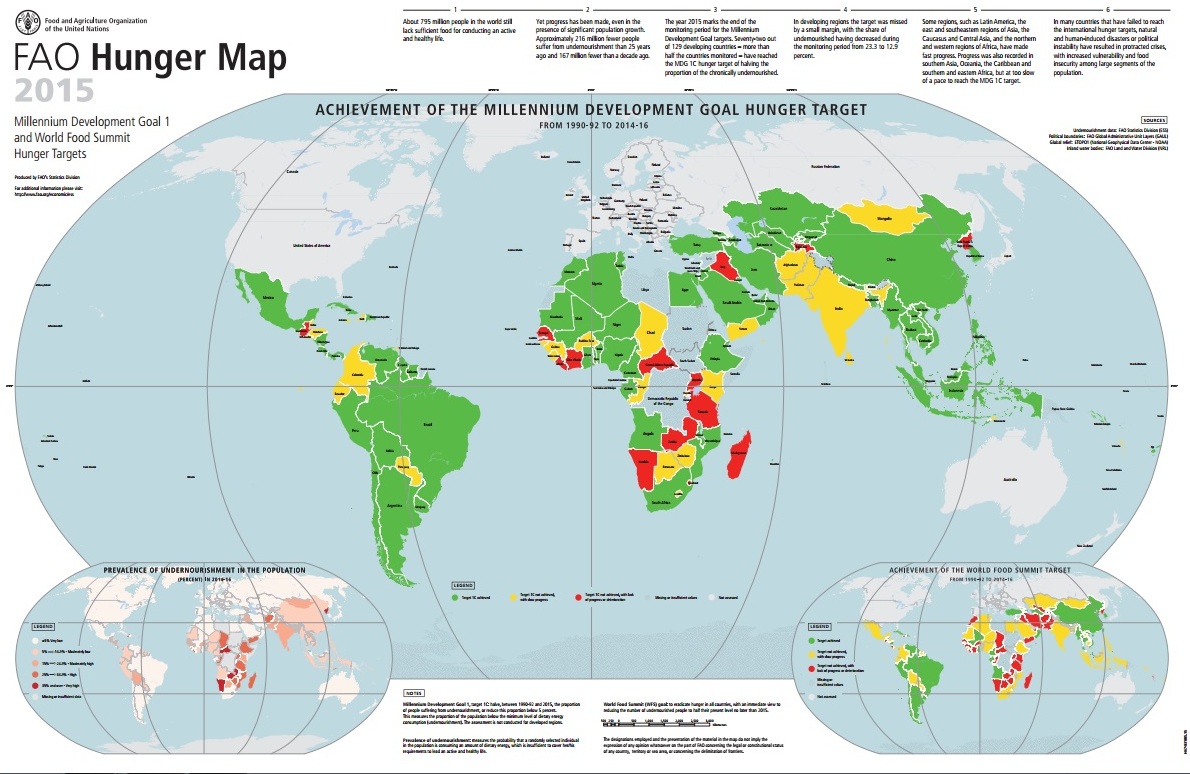Future of World Food Security at Risk
Future of World Food Security at Risk
According to the recent FAO report of 2017, the goal of ending hunger by 2030 will not be achieved if all governments fail to take determined action in this regard.
As usual, FAO puts the emphasis not on large investments in agriculture, not on large manufacturing aggregations, not on so many discourseable, anachronistic, and ecologically incorrect things done by European policies with the Rural Development Program.
According to the FAO, but now is a choir that stands out from most parts of the planet, we need to support small farmers, helping them access to information, markets and technology. All this will be crucial to ensuring the food security of the future.
The future capacity of humanity to feed is endangered by intensified pressures on natural resources, increasing inequality, and the consequences of climate change.
Although significant progress has been made in reducing hunger over the last thirty years, “Growth in food production and economic growth have often led to a heavy cost for the environment.” This is what denies The Future of Food and Agriculture: Trends and Challenges.
“Nearly half of the forests that once covered the Earth have disappeared. The aquifers are running out. Biodiversity has been deeply eroded. ” This is more a war bulletin than the FAO report.

As a result, “the capabilities of the planet could be overcome if current trends continue”. This is the advent of FAO’s Director-General, José Graziano da Silva, in his introduction to the report.
By 2050, the world’s population will probably reach nearly 10 billion people. In a moderate economic growth scenario, this demographic increase will boost world agricultural demand by 50% compared to current levels, intensifying pressure on natural resources already under stress.
At the same time, more people will eat less cereals and larger quantities of meat, fruit, vegetables and food processed following the change of diets that are already going on globally, a trend that will help increase resource pressure Natural causes causing more deforestation, soil degradation and greenhouse gas emissions.
Alongside these trends, climate change on the planet will bring additional obstacles. “Climate change will affect all aspects of food production,” says the report. These include increased variability in precipitation and increased drought and flood frequency.
To achieve the “Fame Zero” goal, efforts must be intensified that go in different directions to many of the inefficient rural policies
The central issue raised by the publication of FAO is whether, in prospect, the world’s agricultural and food systems will be able to meet the needs of a growing world population in a sustainable way.
The immediate answer is yes (so read my latest publication titled: How The Titanic? The food systems on the planet are able to produce enough food but to do so and in a sustainable way and to ensure that all humanity Benefits will be needed “great transformations.” Transformations that go in the direction of a completely different agricultural model than the one thought and put into effect in Europe by the EU.
“Without a commitment to investing and reorganizing food systems, too many people will still suffer from hunger in 2030 – the year when the new Sustainable Development Goals (SDG) agenda included the elimination of chronic food insecurity and malnutrition “He warned.
“Without much effort to promote development in favor of the poor, reduce inequality and protect the most vulnerable people, more than 600 million people will still be slandered in 2030.” Indeed, the current rate of progress would not even be enough to eradicate hunger for 2050.
The question at this point is: where will our food come from?
Given the limited scope for expanding agricultural use of land and water resources, the increase in production needed to meet the growing demand for food will mainly be due to improved productivity and increased resource efficiency.
However, there are worrying signs that yield growth has now stabilized for major crops. And the report notes that since the ’90s the average increments of corn, rice and wheat crops worldwide have generally been around slightly more than 1% per year.
To address these and many other challenges, the report says that moving forward as if nothing is a viable option.
Therefore, the increase in yields can not be the solution of hunger in the world, but the increase in the ecological efficiency of agricultural systems to solve the issue.
“There will be a need for important transformations in agricultural systems, rural economies and natural resource management, if we are to face the many challenges facing us and realize the full potential of food and agriculture and ensure a safe and healthy future for all People and the whole planet.”
“Agricultural production systems that require intensive use of inputs and resources, which have caused massive deforestation, water scarcity, soil depletion and high levels of greenhouse gas emissions, can not provide food and agricultural production Sustainable, “adds the report.
The era of hyper-mechanized, energetic, ecologically incorrect, poor knowledge and traditions is over: the era of a new Agricultural Humanity is emerging, but there is so much work, and it is not technologically above all cultural.
The main challenge is to produce more with less, preserving and enhancing the living conditions of small farmers and ensuring food access to the most vulnerable. For this, a dual-track approach is needed combining investment in social protection, dealing with immediate malnutrition, and investing in productive activities in favor of the poor – particularly in agriculture and rural economies – in order to make a sustainable increase The opportunities to generate income.
The world will need to move to more sustainable food systems that make more efficient use of land, water and other production factors, and greatly reduce their use of fossil fuels, leading to drastic cut in greenhouse gas emissions Agriculture, better conservation of biodiversity, and reduction of waste. This will require more investment in agricultural and agri-food systems (not so much money-only), but also in research and development, in promoting innovation, supporting sustainable production increases, and finding better ways to cope with problems such as Water scarcity and climate change.
In addition to increasing production and responsiveness to crises, equally crucial will be the creation of food supply chains that better connect farmers in low and middle income countries to urban markets – along with measures to ensure consumer access to A nutritious and safe food at affordable prices, such as pricing policies and social protection programs.
FAO’s report identifies 15 trends and 10 challenges that affect the world’s food systems:
Let us see them together as they have been stated in the report.
The 15 Trends:
- Rapid growth of the world population, characterized by “critical” growth zones, urbanization and aging.
- Different trends in economic growth, family income, agricultural investment, and economic inequality.
- Increased competition for natural resources.
- Climate change.
- Stabilize the agricultural yield.
- Cross-border illnesses.
- Increased conflicts, crises and natural disasters.
- Persistent poverty, inequality and food insecurity.
- Dietary changes affecting nutrition and health.
- Structural changes in economic systems and employment implications.
- Increased migration.
- Changing food systems and consequences for farmers’ livelihoods.
- The persistence of loss and waste of food.
- New mechanisms of international governance to respond to food and nutrition safety issues.
- Changes in international financing for development.
The 10 Challenges
- Sustainably improve agricultural productivity to meet the increased demand.
- Ensure a sustainable basis for natural resources.
- Facing climate change and the intensification of natural disasters.
- Eliminate extreme poverty and reduce inequalities.
- Put an end to hunger and all forms of malnutrition.
- Make food systems more efficient, inclusive and resistant.
- Improve income opportunities in rural areas and address the root causes of migration.
- Strengthen the ability to respond to prolonged crises, disasters and conflicts.
- Prevent emerging cross-border threats to agriculture and food systems.
- Address the need for consistent and effective national and international governance.
How to say that the last set up of PSR 2014-2020 was born old and defeated before it was completed.
The good news is that many businesses, small entrepreneurs, and young farmers, though not technically, are starting to understand it from a sensible point of view.
The future has begun. We can think of writing a new story. Full speed ahead.
Guido Bissanti

